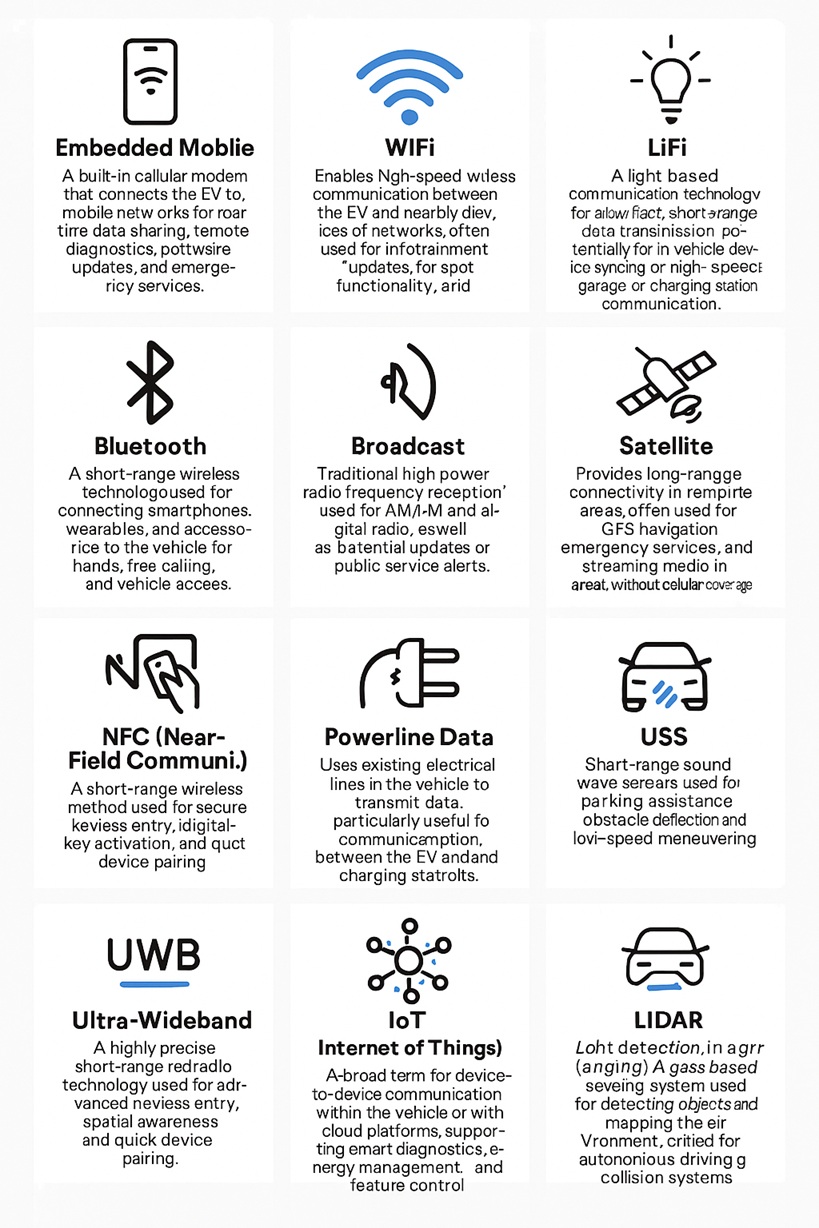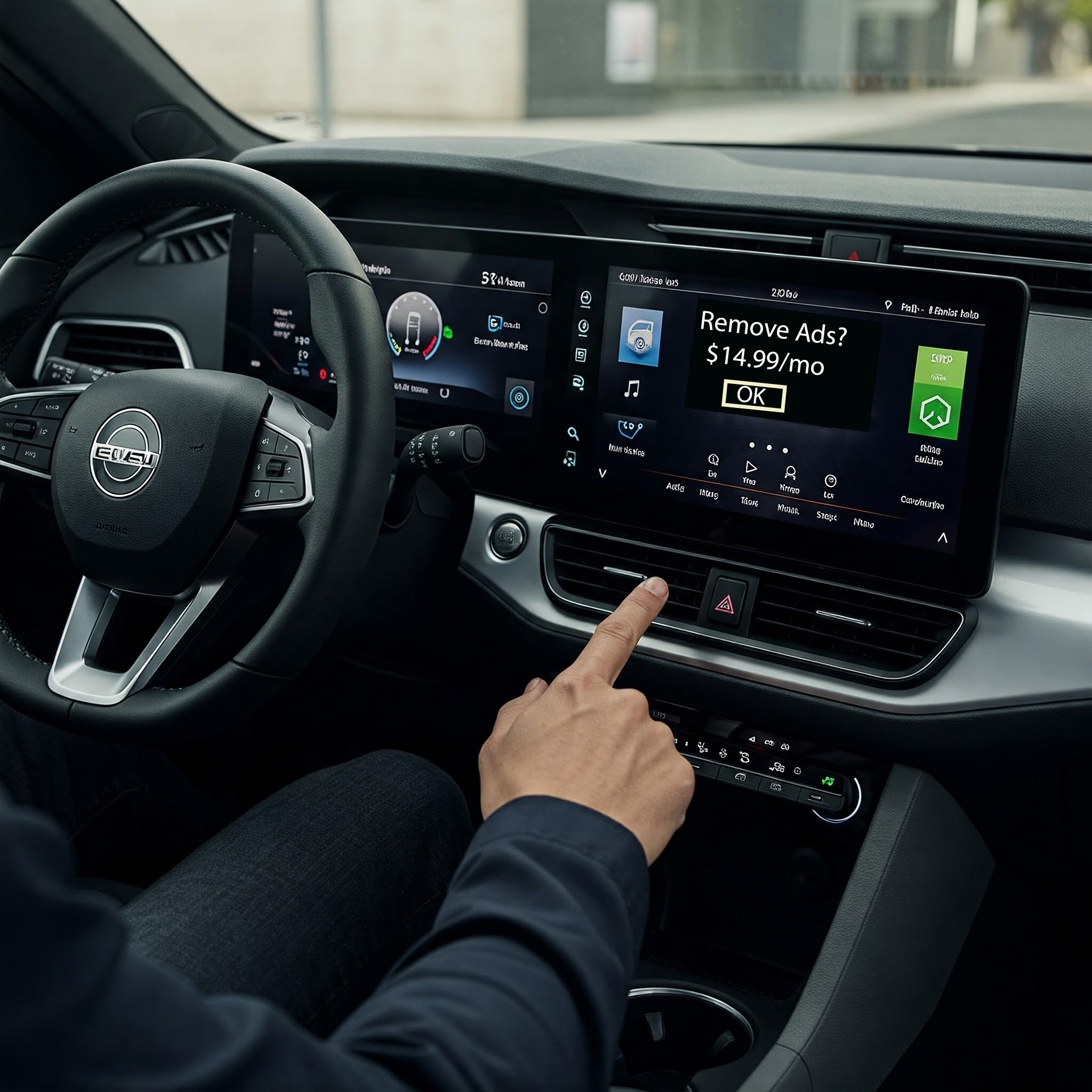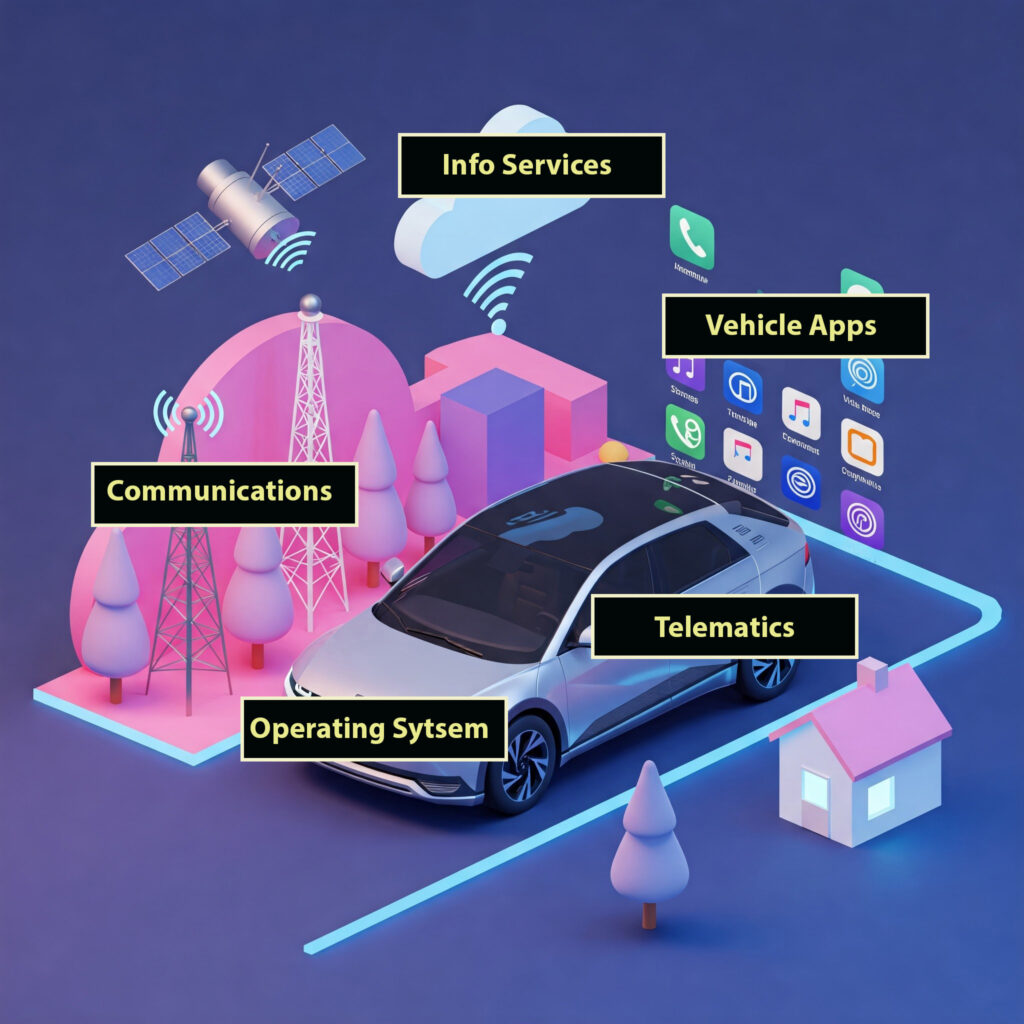By: Lawrence Harte
Connected Electric Vehicles (EVs) have advanced communication technologies, intelligent software, and integrated services that make driving safer, smarter, and more personalized. These vehicles are not only electrified—they are digitally empowered. This article explores the essential components of connected EVs, why they matter, and what businesses in the EV ecosystem need to know to stay ahead in the rapidly changing automotive landscape.
Connected EV capabilities can surprise manufacturers, dealers, technicians and the vehicle owners. Aside from the different propulsion system, connected EVs have lots of interactive devices and communicate with networks and user devices.
Some surprising things about Connected EVs:
– Advanced Features – combine amazing interactive devices and connected services
– Lower Maintenance Costs – monitoring, analysis and predicted failures
– EV Tech Skill Requirements – automotive technicians need to understand the systems in the vehicle and how they work with other equipment including EV chargers, cloud services and smartphones.
Connected EV Features and Services
Connected EVs offer many in-car and remote features that enhance user experience and operational efficiency. These include real-time monitoring and diagnostics, remote start and climate control, over-the-air (OTA) software updates, predictive maintenance, and advanced infotainment systems. Users benefit from greater convenience and lower maintenance costs, while manufacturers gain insights and opportunities for recurring revenue through app subscriptions and digital services.
Connected EV Communications

Figure 1 – Connected EV Communication Types
Connected EVs often include 10 or more types of connectivity. These include embedded mobile networks, Wi-Fi, Bluetooth, LiFi, NFC, satellite, UWB, powerline data, V2X, in-car data networks, and even LIDAR. This multi-layered communication enables seamless interaction between vehicles, users, cloud platforms, charging stations, and third-party services. These connections support everything from real-time navigation to remote diagnostics and infotainment delivery.
EV Operating System – EVOS
At the heart of every connected EV is the EV Operating System (EVOS)—a software platform that manages vehicle hardware, sensors, and services. Similar to Android or iOS, the EVOS is optimized for safety, reliability, and real-time processing.
The EVOS integrates software and hardware systems to ensure optimal performance, safety, and user experience. Vehicle Control Units (VCUs) are onboard electronic devices that process real-time data to coordinate subsystems and key vehicle functions such as motor control, battery management, and regenerative braking, with many EVs containing multiple VCUs. At the core of these systems is the Real-Time Operating System (RTOS), a lightweight, deterministic OS typically managed by the manufacturer, designed to ensure that critical operations like braking, steering, and sensor responses occur instantly and reliably. To maintain both safety and flexibility, EVs use operating system partitions that separate proprietary, safety-critical functions from open-source, infotainment, and third-party applications, which enhances security and regulatory compliance. Interfaces and apps serve as the communication bridge between these systems, enabling seamless integration of features such as navigation, media, diagnostics, and cloud-connected services. Additionally, installing and updating software is made efficient through over-the-air (OTA) and dealer-installed updates, allowing manufacturers to introduce new features, fix bugs, and enhance vehicle performance remotely without requiring in-person service appointments.
Surprising Factoid – Some EV car software operating systems have over 500 million lines of code – 10x more than a Boeing 787. The EV software code must be regularly updated to support security, performance and to add new features.
Telematics and Human Interface Devices (HIDs)
Telematics systems gather and transmit data about vehicle status, performance, and location. Meanwhile, Human Interface Devices provide intuitive ways for drivers and passengers to interact with the car.
Modern electric vehicles are integrating advanced human-machine interfaces (HMIs) to create a more intuitive and personalized driving experience. Touchscreens, trackpads, and gesture controls offer seamless, contactless interaction with infotainment and vehicle functions. Voice and AI assistants, powered by speech recognition and smart algorithms, allow drivers to operate navigation, media, and settings entirely hands-free. Haptic feedback systems, embedded in steering wheels, seats, and displays, provide tactile responses to enhance user engagement and deliver real-time alerts. Augmented displays such as digital instrument clusters, heads-up displays (HUDs), and smart glass present critical vehicle and environmental information in the driver’s line of sight, boosting safety and awareness. Additionally, biometric and smart access technologies—including fingerprint scanning, facial recognition, and digital key apps—strengthen vehicle security while enabling customized driver profiles and settings.
Surprising Factoid – HIDs such as heads up displays or hand gesture controls enhance safety, efficiency, and user experience in connected EVs. Many EVs with heads up displays can reduce driver distraction by over 30%.
Vehicle Apps
Vehicle apps are software tools that run inside the EV or on connected smartphones to enable key functions like remote start, route planning, diagnostics, and media control. They can be embedded in the EVOS or linked via platforms like Android Automotive OS (AAOS), which allows third-party apps to deliver navigation, streaming, and infotainment directly through the vehicle’s interface.
Vehicle apps play a crucial role in enhancing the digital experience within modern electric vehicles, offering convenience, personalization, and connectivity. User interface software forms the interactive layer of these apps, allowing drivers and passengers to control vehicle functions through touchscreens, voice commands, or other intuitive inputs. Embedded apps are pre-installed on the vehicle’s internal systems and deliver core features such as navigation, climate control, and music playback without needing a smartphone connection. Linked apps extend functionality by connecting the vehicle’s infotainment system to external devices like smartphones, enabling access to mobile services such as messaging, navigation, and media streaming directly through the car’s display. Supporting these features are app interfaces—standardized frameworks such as APIs or middleware—which allow third-party developers to seamlessly integrate their apps with the vehicle’s software. To safeguard these digital experiences, app security is implemented through encryption, authentication, and secure development practices, ensuring the protection of vehicle systems and user data from cyber threats.
Vehicle apps not only improve the user experience, they also can generate significant revenue for manufacturers through app sales, subscriptions and advertising.
Information Services
Connected electric vehicles (CEVs) are transforming the in-car experience through a suite of advanced infotainment technologies. Digital media services, including both broadcast and streaming platforms, offer passengers a wide range of connected content. Voice and gesture controls, powered by advanced recognition systems, enable hands-free operation of navigation, media, and vehicle settings—enhancing driver focus and safety. Personalized experiences, driven by AI and cloud-based user profiles, allow infotainment systems to automatically adjust music, climate, and seat settings to individual preferences. High-resolution displays, including large touchscreens and heads-up displays (HUDs), provide intuitive access to entertainment, diagnostics, and real-time road data. Additionally, interactive entertainment features such as rear-seat displays, streaming services, and in-car gaming are turning EV cabins into immersive digital environments tailored to modern lifestyles.
 Surprising Factoid – Vehicle owners may need to pay car manufacturers to turn off ads inside their car! This is similar to paying a monthly fee to turn off Youtube Ads. The profit from in-car advertising can be much higher than Internet, TV and other types of advertisers because the ads can be targeted to specific user profiles and they can require interactive responses. For example, when the vehicle is first turned on, an ad can appear on the dashboard which requires the driver to press the Accept or OK button to get rid of the message before they can start driving.
Surprising Factoid – Vehicle owners may need to pay car manufacturers to turn off ads inside their car! This is similar to paying a monthly fee to turn off Youtube Ads. The profit from in-car advertising can be much higher than Internet, TV and other types of advertisers because the ads can be targeted to specific user profiles and they can require interactive responses. For example, when the vehicle is first turned on, an ad can appear on the dashboard which requires the driver to press the Accept or OK button to get rid of the message before they can start driving.
About Lawrence Harte
Lawrence Harte is the publisher and editor in chief of EV Business Magazine and host of EV Business Podcast. He has authored more than 141 books (mostly communications, media and business). Between 2005 and 2025, he interviewed more than 4,137 executives and technologists in the communication industry.


